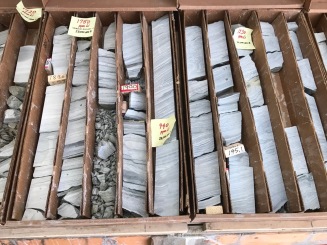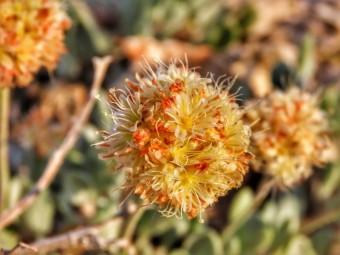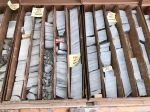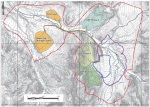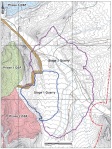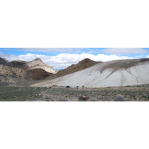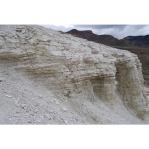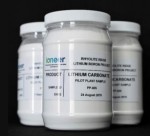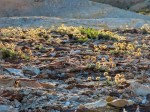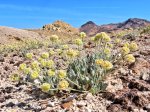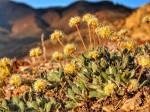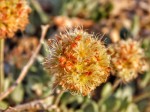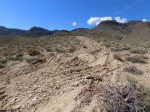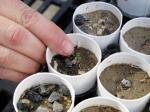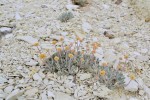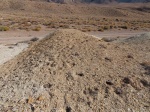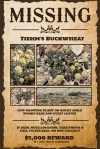Ioneer Rhyolite Ridge
Feb. 3, 2023 – Bureau of Land Management Extends Public Scoping Period an Additional 30 Days
Elko Daily Rhyolite Ridge Comment Period Extended Again
BLM National NEPA Register – Rhyolite Ridge Lithium-Boron Mine Project
Image Updates – Go to Image Gallery
Jan. 20, 2023 – U.S. Cites Ioneer for Trespassing in Protected Tiehm’s Buckwheat Habitat
Center for Biological Diversity – U.S. Tags Mining Company for Trespassing in Protected Tiehm’s Buckwheat Habitat
Las Vegas Review Journal – BLM Cites Mining Company for Trespassing on Endangered Wildflower Habitat
The Associated Press – Lithium Miner Cited for Violating Endangered Flower Habitat
Inside Climate News – A Rare Plant Got Endangered Species Protection This Week, but Already Faces Threats to Its Habitat
Jan. 9, 2023 – Lawsuit Launched to Protect Tiehm’s Buckwheat from Cattle Trampling
Center for Biological Diversity – Lawsuit Launched to Protect Tiehm’s Buckwheat from Cattle Trampling. Destruction Discovered After Nevada Wildflower Protected as Endangered
The Associated Press – Conservationists: Feds Not Protecting Rare Plant From Cattle
Dec. 14, 2022 – Tiehm’s Buckwheat Protected as Endangered Species
Center for Biological Diversity – “Tiehm’s Buckwheat Protected as Endangered Species – Rare Nevada Wildflower Threatened by Lithium Mine”
The Associated Press – “Nevada flower listed as endangered at lithium mine site”
E&E News – “Biden admin protects rare plant near proposed lithium mine”
April 23, 2021 – Federal Judge Compels US Fish and Wildlife Service to Decide on Tiehm’s Buckwheat Protections
The Center for Biological Diversity announced a legal victory that compels the federal government to decide on Tiehm’s Buckwheat protections. U.S. District of Nevada Judge James C. Mahan said the situation was an emergency which warranted swift action.
Judge Mahan ruled that an endangered species listing decision must be issued within 30 days, saying that the plant’s situation qualifies as an “emergency posing a significant risk to the well-being” of Tiehm’s buckwheat.
Center for Biological Diversity – “Legal Victory Compels Federal Government to Decide on Tiehm’s Buckwheat Protections”
Las Vegas Sun – “Judge sets deadline for decision on protecting rare Nevada plant”
Nevada Current – “Judge gives feds 30 days to decide if wildflower is endangered”
Sierra Nevada Ally – “Federal judge compels US Fish and Wildlife Service to decide on Tiehm’s Buckwheat protections”
April 9, 2021, The Associated Press reported that the BLM recognized that Tiehm’s buckwheat needed to be protected 23 years ago. It was first suggested in 1994 that the site be declared a special botanical area and made off-limits to mining.
The Associated Press – “Old documents fuel latest bid to halt Nevada lithium mine”
Documents indicate that the BLM dropped the decision to protect the plant in 1997 due to opposition from local counties. The opposition from one local county continues as reported by the Pahrump Valley Times Sept. 28, 2020, where Tim Hipp, Esmeralda County commissioner, said he wants to collect more public input about the proposal to list Tiehm’s buckwheat as endangered species. Hipp said that without an injection of new capital, the county’s population would continue to drop.
Pahrump Valley Times – “Esmeralda County official concerned about financial impact of wildflower gaining endangered status near proposed lithium mine”
Several articles were written which discussed what may have caused the destruction to a large part of the Tiehm’s buckwheat plants in the first place. No one can say for certain what caused the damage.
Government agencies and Ioneer lean toward the damage being done by animals. Environmental groups, scientists and biologists could not say for certain that animals caused the damage and there was a chance it was human caused.
What is unusual and suspicious about the damage to Tiehm’s buckwheat is that there have been no other reports of damage to the plant since the original discovery.
One thought about this case could possibly be that Ioneer may have seen the buckwheat as an obstacle to their project and removed the plants or someone did it for them. Possibly even without their knowledge. The extent of an investigation into this possibility is not known.
There are at least 16 other lithium exploration project sites in the immediate area of the Ioneer site that could be in direct competition with Ioneer. It is possible that these other projects would benefit if the Ioneer project were to not be completed. But this possibility does not appear to have been investigated.
Local counties were concerned with the Tiehm’s buckwheat being granted an endangered status 23 years ago and at least Esmeralda County is concerned about the possibility of the endangered listing now. It is possible that the damage was done thinking that the action would help ensure local economic gain or by someone hoping for employment at the site. But this possibility also does not appear to have been investigated.
Ioneer issued a press release after the damage was discovered and denied that the damage was caused by humans and was done by rodents. Ioneer does not appear to have considered any other possibilities for the damage.
The Associated Press – “Officials: Rodents likely destroyed rare plants at mine”
Sierra Nevada Ally – “US Fish and Wildlife Service concludes that animals killed nearly half of rare Tiehm’s buckwheat population”
The Nevada Independent – “The curious case of a rare plant’s destruction raises further questions about the extinction crisis, climate change and the role of humans”
Jan. 28, 2021, the Sierra Nevada Ally reported that the Ioneer Rhyolite Ridge pilot plant successfully converted lithium carbonate into the valued battery-grade lithium hydroxide.
Sierra Nevada Ally – “Lithium miner, processor sees opportunity under Biden’s green imperatives”
Ioneer expects to receive necessary federal, and state permits for the Rhyolite Ridge project in fourth quarter of 2021 and be construction ready.
As per estimates, the Rhyolite Ridge project has 146.5 million metric tonnes, including an ore reserve of 60 million metric tonnes.
Over the mine life of 26 years, the mine is expected to produce 63.8 million metric tonnes at an average annual rate of 2.5 million metric tonnes per year.
Sept. 18, 2020 – More than 17,000 rare wildflowers under review for Federal protection destroyed on Ioneer’s project site.
The Center for Biological Diversity reported that someone dug up and destroyed as much as 40% of Tiehm’s buckwheat population. The plants are located on Ioneer’s proposed Rhyolite Ridge lithium mine site.
Patrick Donnelly, the Nevada State Director for the Center for Biological Diversity said “This appears to have been a premeditated, somewhat organized, large-scale operation aimed at wiping out one of the rarest plants on Earth, one that was already in the pipeline for protection. It’s despicable and heartless.”
Read the Center for Biological Diversity press release.
Read the Sept. 8, 2020, report by Leger Lab, University of Nevada Reno Dept. of Biology on the Eriogonum tiehmii herbivory observations.
The status of Ioneer’s involvement in the destruction of the plant, if any, is not known at this time.
Some mining companies are known for poor land stewardship and unethical behavior.
Earlier this year Rio Tinto destroyed two 46,000 year old Aboriginal rock shelters for additional profits.
Alan Davies, the former CEO of energy and industrial minerals for Rio Tinto, was fired from Rio Tinto November 2016 over a $10.5 million payment to a consultant to an African president. Davies strongly denied the allegations and said there were no grounds for his termination. July 28, 2020, Mining reported that Rio Tinto is in discussions with the UK Serious Fraud Office over the payment involving Davies and others at Rio Tinto.
In a sheer coincidence, and not connected to the destruction of the Tiehm’s buckwheat in any manner, Alan Davies is a non-executive director with Ioneer.
Articles:
KPIC “Conservationists say more than 17,000 rare Nevada wildflowers dug up and destroyed”
The Guardian “‘Unfathomable destruction’: thousands of rare wildflowers wiped out in Nevada”
Las Vegas Sun “Irreplaceable desert plants destroyed in western Nevada; human interference suspected.”
The Sierra Nevada Ally “Rare Tiehm’s Buckwheat population ravaged near Silver Peak, Nevada”
Nevada Current “Conservationists say humans uprooted flowers, lithium miner blames rodents”
Associated Press “Massive damage of rare plants probed at Nevada mine site”
A Sept. 16, 2020, update on INR (Ioneer) from Trading Central reported that INR is still in a downtrend and has not come close to breaking resistance line of 1.22.
Sept. 2, 2020 – The Center for Biological Diversity filed a complaint with the U.S. Securities and Exchange Commission asserting that Australian mining company Ioneer provided materially misleading statements to investors.
In a July 2020 quarterly report for investors Ioneer stated it planned to “be shovel ready” by the second quarter of 2021. But a permitting timeline spreadsheet obtained from the Bureau of Land Management (BLM) indicates that permitting will not be complete until at least December 2021.
The Center for Biological Diversity said BLM has not yet initiated scoping, a public-information-gathering process that signals the beginning of environmental review. Environmental impact statements for projects of the size, scope, and complexity of the Rhyolite Ridge mine almost always take more than a year to complete. According to BLM’s spreadsheet, scoping will start January 2021.
Ioneer’s proposed mine will also need approval from other state and federal agencies, including water-quality and reclamation permits from the Nevada Division of Environmental Protection and water-rights applications and change permits from the Nevada Division of Water Resources.
The Center for Biological Diversity added that Ioneer also will need permits from the Nevada Division of Forestry and U.S. Fish and Wildlife Service if those agencies decide to protect Tiehm’s buckwheat under state and federal laws.
Patrick Donnelly, the Nevada State Director for the Center for Biological Diversity said “Ioneer has chosen one of the most biologically sensitive locations in Nevada to site its Rhyolite Ridge mine. Investors shouldn’t be deceived about the time involved for the extremely complicated permitting this mine will require.” (See complaint and associated documents.)
In an article by The Associated Press, SEC complaint filed over mine that could threaten rare plant, the BLM confirmed that it does not expect to decide whether to approve the project before January 2022.
Aug. 4, 2020 – The Associated Press published an exclusive article that indicates a mine consultant agrees that a Nevada plant is in danger. A botanist hired by lithium mining company Ioneer believes the rare desert wildflower, Tiehm’s buckwheat, should be protected under the Endangered Species Act. The candid disclosure was found in 500 pages of emails obtained by the Center for Biological Diversity through a public records request. The seemingly contentious relationship between Ioneer and the scientists with researchers continually pushing back against company pressure to hastily publicize success is also discussed in the article.
Australian-based Ioneer Ltd. spent $60,000 on a yearlong study at the University Nevada Reno (UNR) to grow hundreds of Tiehm’s buckwheat seedlings in a campus greenhouse to determine whether it’s feasible to transplant them in the wild to bolster its limited population. Ioneer announced in April a $168,000 grant to UNR to extend a research contract for five years to study Tiehm’s buckwheat.
July 24, 2020 – Two early modern lithium-boron explorations have occurred at Rhyolite Ridge. In the 1980s Rio Tinto’s U.S. Borax collected surface samples and drilled a basin of lithium and boron-rich sediments and completed 57 holes. The area was known as the North Borate Hill project. The work by U.S. Borax was focused on boron mineralization and the lithium was ignored. U.S. Borax also drilled 12 holes at the South Borate Hill project where they discovered higher lithium values.
Between 2010 and 2011 American Lithium Minerals and Japan Oil, Gas and Metals National Corporation conducted additional lithium exploration in the south basin area. The exploration included 465 surface and trench samples and 36 drill holes.
June 3, 2016, Global Geoscience, an Australian-based lithium-boron developer, announced that it secured an option to acquire a 100% interest in the advanced Rhyolite Ridge Lithium-Boron Project. The project area covers two known lithium-boron deposits covering approximately 5,400 acres.
May 23, 2017, Global Geoscience announced the appointment of two nonexecutive directors. One was John Hofmeister, the former president of Shell Oil. The second was Alan Davies, the former CEO of energy and industrial minerals for Rio Tinto. News reports related that Alan Davies was fired from Rio Tinto November 2016 over a $10.5 million payment to a consultant to an African president. Davies strongly denied the allegations and said there were no grounds for his termination.
June 6, 2018, development plans were released for the Rhyolite Ridge lithium-boron project.
June 7, 2018, Global Geoscience announced two senior commercial executive appointments. Michael Le Page was appointed as the commercial director and has close to 40 years of industry experience including 20 years with Rio Tinto which included work in Rio Tinto Minerals and U.S. Borax. Yoshio Nagai was appointed as the sales and business development director and has over 25 years of international experience which includes 10 years with Rio Tinto working with borates, salt and talc products.
Sept. 28, 2018, Global Geoscience announced the change of the company name to Ioneer ltd. The new name was approved by the shareholders at the annual general meeting Oct. 31, 2018. The ASX code “INR” will be used for trading under the new Ioneer name.
Feb. 14, 2019, the Houston Chronicle reported in the article “Wildcatters in the Nevada desert seek the 21st century version of Spindletop” comparing the 1901 discovery of oil at Spindletop in South Texas to the current U.S. lithium exploration and the work being done by Ioneer at Rhyolite Ridge.
April 29, 2019, an independent research and estimated fair value report was published on Ioneer’s Rhyolite Ridge which includes speculation on the future of lithium and boron mining including Ioneer’s competitor Rio Tinto.
The Australian reported July 12, 2019, that Rio Tinto is linked to an interest in Ioneer’s Rhyolite Ridge lithium undertakings. Analysts have been examining if major miners such as Rio Tinto might buy into lithium at a time when they are struggling to find production growth opportunities. It is also thought that Ioneer’s Rhyolite Ridge could be too small of a market for Rio Tinto. But Oct. 31, 2019, Reuters reported that Rio Tinto was pivoting toward smaller finds that had growth potential. In another article the Australian Financial Review reported that Rio Tinto CEO Jean-Sebastien Jacques believes the future of mining will be in smaller mines that deliver faster turns on investment. Jacques also said ”In terms of resource development maybe the majors also need to think more like fast moving juniors.”
Aug. 7, 2019, S&P Global Market Intelligence reported that Ioneer has been working with institutional funds to help them better understand the boron market. Ioneer looks to take on Rio Tinto’s boron project which produces 30% of global boron production and Turkish group Eti Maden which produces 50% of global boron production. Ioneer’s rhyolite Ridge will be a simple open pit operation compared to Rio Tinto’s Jadar project in Serbia which will be an underground operation and will be more costly to operate. Rio Tinto’s Jadar faces technical challenges and has been in the pre-feasibility stage for several years.
Oct. 8, 2019, the Center for Biological Diversity submitted an emergency petition to the U.S. Fish and Wildlife Service to protect Tiehm’s buckwheat (Eriogonum tiehmii) under the Endangered Species Act. The plant is threatened by mineral exploration at the proposed Ioneer Rhyolite Ridge open pit mine. Tiehm’s buckwheat is a rare wildflower found only on 21 acres of public land in the remote Silver Peak Range of Esmerelda County, Nevada. It is one of the few plants to grow in the highly mineralized soil it is adapted to.
Ioneer has been conducting exploration activities in the buckwheat’s habitat, including grading new roads and well pads and drilling test wells. The company has already bulldozed a road between two of the six populations of buckwheat, potentially irreversibly severing their reproductive connectivity. Long-term plans call for an open pit mine to produce lithium and boron. The proposed mine’s project area includes the entire area where Tiehm’s buckwheat is known to grow. A petition was also filed with the Nevada Division of Forestry to protect the plant. That agency has authority under state law to protect “various species of flora which are threatened with extinction.”
Oct. 30, 2019, the Center for Biological Diversity sued to protect the world’s only population of Tiehm’s buckwheat (Eriogonum tiehmii) from harm related to mineral exploration and a proposed open pit mine. The lawsuit, filed in U.S. District Court in Las Vegas, challenges the U.S. Bureau of Land Management decision to approve two exploration projects for the proposed mine as separate operations. In doing so the BLM avoided federal requirements to perform an environmental review and get public input. The exploration projects were just under the acreage limits for this exception and, when combined, are well over the 5 acres that triggers review and public comment requirements.
Nov. 1, 2019, Mining News discusses how Rio Tinto’s intermittent messaging around adding lithium to its portfolio to plug in to the electric vehicle and renewable energy storage revolution has become increasingly confused and could benefit Ioneer’s Rhyolite Ridge project. “Rio’s lithium muddle and why ioneer could benefit.”
Jan. 3, 2020, the Center for Biological Diversity lawsuit against the U.S. Bureau of Land Management has led to an agreement with Ioneer that will temporarily protect the habitat of a rare Nevada wildflower. The agreement to protect the world’s only population of Tiehm’s buckwheat was reached this week between the Center and the mining company. It comes after the Bureau of Land Management terminated the two challenged mining-exploration permits last month.
“Our agreement saves this delicate little flower from immediate danger,” said Patrick Donnelly, Nevada state director at the Center. “But Tiehm’s buckwheat is still threatened by a destructive open-pit mine proposal. Gov. Sisolak and state officials must protect this rare Nevada beauty before it’s too late.”
Jan. 6, 2020, the Reno Gazette Journal reported that Ioneer agreed to a moratorium on new activities at the planned Rhyolite Ridge lithium mine in exchange for the Center of Biological Diversity dropping their lawsuit. The lawsuit also accused the Bureau of Land Management of illegally dividing the mining operations into two separate projects to bypass its own regulations requiring a formal environmental review and public comment on any land disturbances larger than 5 acres. The state of Nevada then announced it was launching a comprehensive review of the status of the wildflower found only in the Silver Peak Range, about 120 miles southeast of Reno.
Feb. 9, 2020, Politico magazine completed an in-depth investigation of Ioneer’s Rhyolite Ridge lithium project and the endangered Tiehm’s buckwheat. The report, “This Is the Wild West Out Here,” also discusses the U.S. Bureau of Land Management (BLM) mining approval process and allegations of improper procedures as described by a BLM employee whistleblower.
May 12, 2020, Ioneer announced that it has formally submitted its project plan of operations to the United States Bureau of Land Management (BLM) for the proposed Rhyolite Ridge lithium-boron project. The submission of the plan is a considered a significant step toward project approval. Once BLM completes the initial review it will register a Notice of Intent in the Federal Register and that will initiate the Environmental Impact Statement (EIS) preparation and public engagement process as part of the National Environmental Policy Act (NEPA).
May 19, 2020, the Center for Biological Diversity reported that as the state of Nevada has been urged to protect a rare wildflower as the permitting process for Ioneer’s Rhyolite Ridge intensifies, 10 conservation groups and a renowned botanist urged the Nevada Department of Conservation and Natural Resources to immediately review the endangered Tiehm’s buckwheat to determine if it should be protected under state law.
July 21, 2020, the Nevada Independent published an article on the status of Tiehm’s buckwheat, “Scientists urge state to protect buckwheat threatened by lithium mining.”
July 22, 2020, the U.S. Fish and Wildlife Service announce 90-day findings on two petitions to add species to the List of Endangered and Threatened Plants under the Endangered Species Act of 1973, as amended (Act). Based on our review, we find that the petitions present substantial scientific or commercial information indicating that the petitioned actions may be warranted. Therefore, with the publication of this document, we announce that we plan to initiate status reviews of the Las Vegas bearpoppy (Arctomecon californica) and Tiehm’s buckwheat (Eriogonum tiehmii) to determine whether the petitioned actions are warranted.
Ioneer Rhyolite Ridge on Google Maps
YouTube Rhyolite Ridge Quarry Spent Ore Storage Facility (SOSF) Construction, Operation & Closure Simulation
Image Gallery
(Please notify author on the website contact page for errors, omissions or suggestions.)
